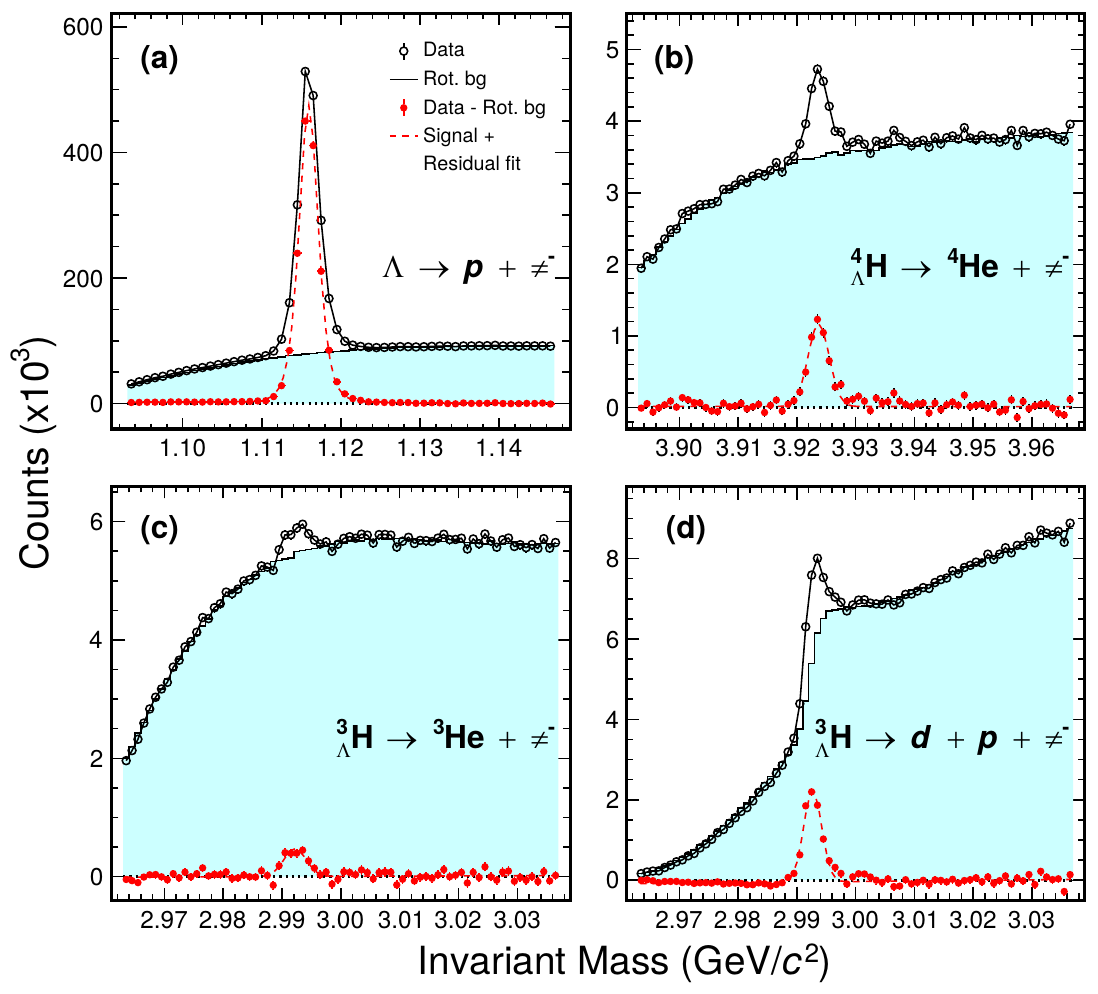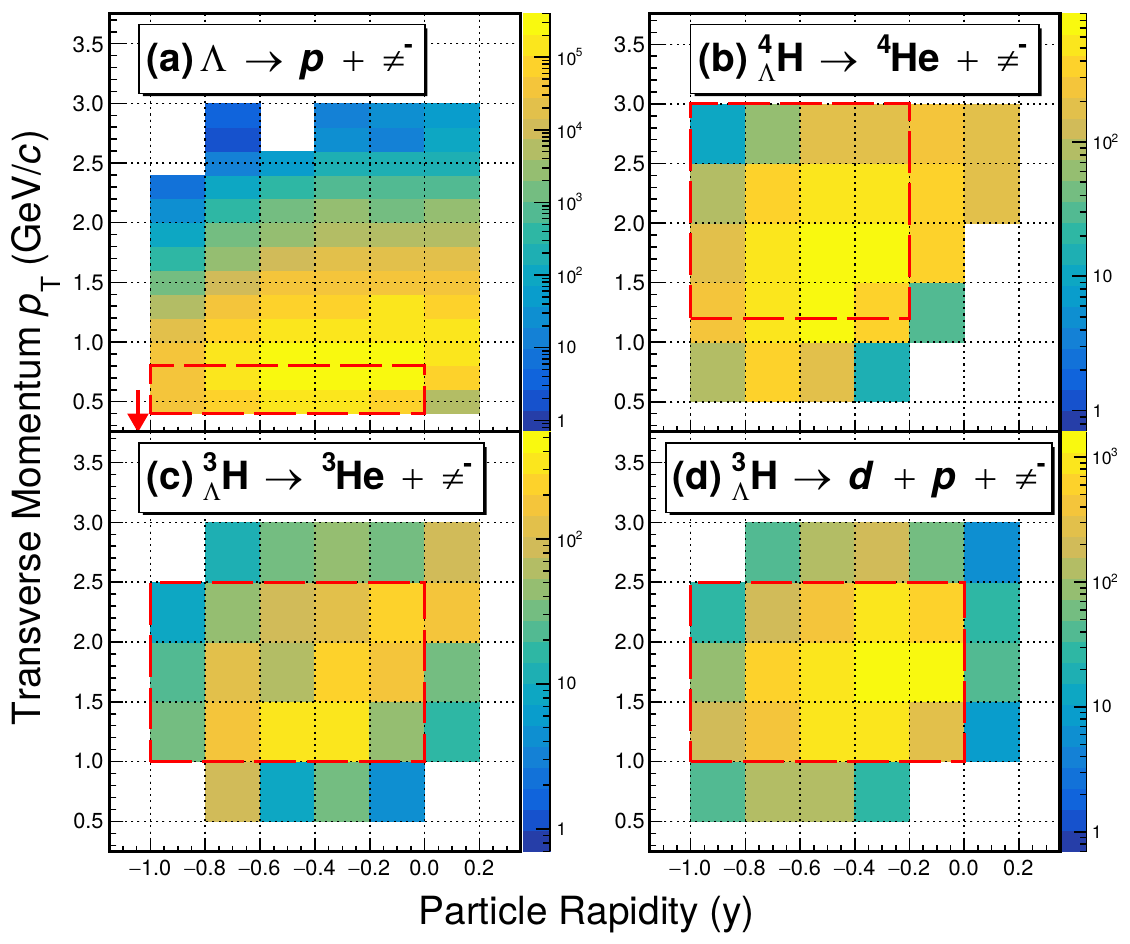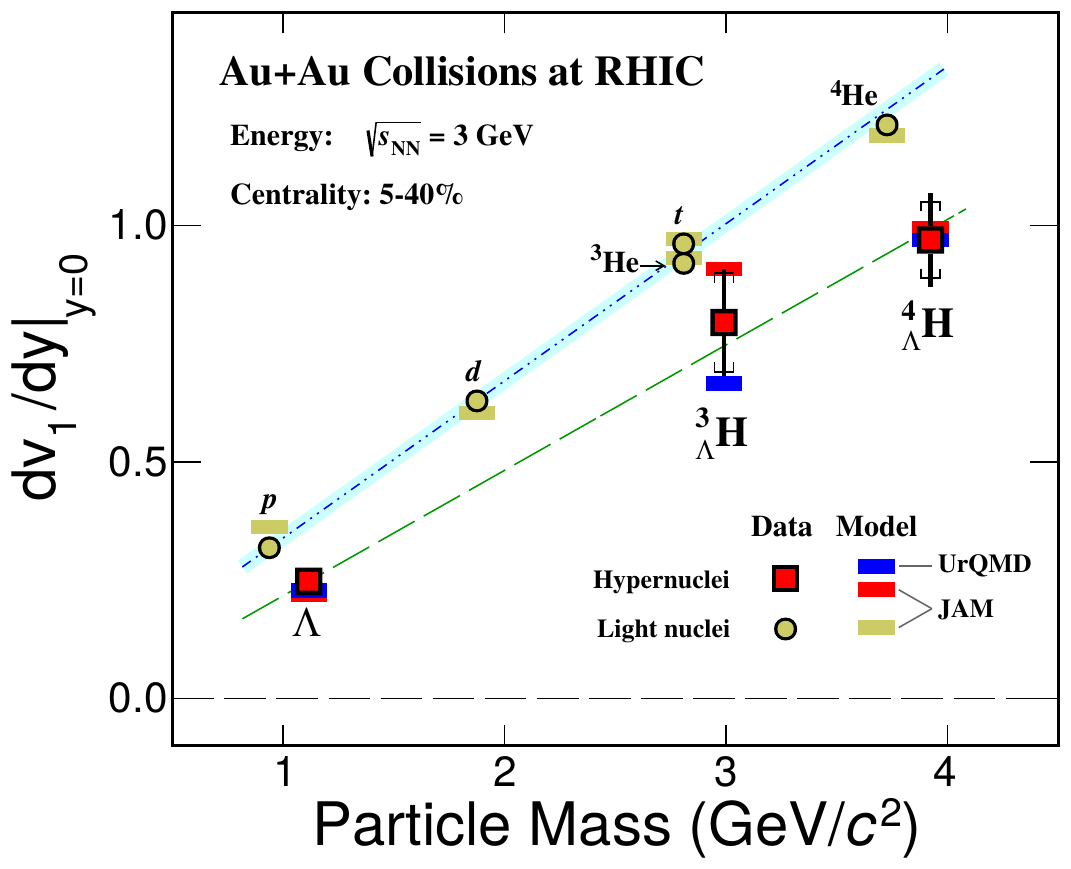First Observation of Directed Flow of Hyper-nuclei H3L and H4L in 3 GeV Au+Au Collisions at RHIC
Title: First Observation of Directed Flow of Hyper-nuclei H3L and H4L in 3 GeV Au+Au Collisions at RHIC
PAs: X. Dong, X.H. He, C.L. Hu, Y.J. Ji, Y.H. Leung, N. Xu, Y.P. Zhang, F.Y. Zhao
Target Journal :Physical Review Letters
Paper draft: drupal.star.bnl.gov/STAR/system/files/HyperNucleiFlow_PaperDraft_v7.pdf
Analysis note : drupal.star.bnl.gov/STAR/starnotes/private/PSN0787
Paper proposal : drupal.star.bnl.gov/STAR/blog/clhu/h3l-and-h4l-directed-flow-measurements-auau-collisions-3-gev-star-detector-and-paper-pwgc-
Codes on RCF: $CVSROOT/offline/paper/psn0787
Supplemental material: drupal.star.bnl.gov/STAR/system/files/HyperNucleiFlow_SupplementalMaterial_v4_1.pdf
Outline
Abstract
We report here the first observation of directed flow (v1) the of hypernuclei H3L and H4L in mid-central Au+Au collisions at √sNN = 3 GeV at RHIC.
These data are taken as part of the beam energy scan program carried out by the STAR experiment. From 165 million good events in 5-40% centrality,
about 8400 H3L and 5200 H4L candidates are reconstructed through two- and three-body decay channels. We observe that these hypernuclei exhibit
significant directed flow. Comparing to that of light nuclei, It is found that the mid-rapidity v1 slopes of H3L and H4L follow baryon number scaling,
implying that the coalescence is the dominant mechanism for these hypernuclei production in such collisions.
Hyperon-nucleon (Y-N) interaction is important for us to understand nuclear matter formed in high-energy nuclear collisions as well as the structure
of compact stars. Hydrodynamic flow is driven by pressure gradient. Studyi collectivity of hypernuclei will enable us to extract information on Y-N
interactions under finite pressure in the high baryon density region.
This paper will be the first report on such study.

Fig. 1. Reconstructed Λ hyperon and hypernuclei invariant mass distributions from √sNN = 3 GeV Au+Au collisions in the corresponding pT−y
regions listed in Table I. While top panels are for Λ → p + π− and H4L → 4He + π− , bottom panels represent the hypertriton two-body decay
H3L → 3He + π− and three-body decay H3L → d + p + π− , respectively. Combinatorial backgrounds, shown as histograms, are constructed
by rotating their daughter particles. Background-subtracted invariant mass distributions are shown as filled circles.

Fig. 2. Λ hyperon and hypernuclei acceptance, shown in pT versus y, from the √sNN = 3 GeV Au + Au collisions. Dashed rectangular
boxes illustrate the acceptance regions used for directed flow analysis, and the red arrow in panel a) represents the target rapidity (ytarget = −1.045).

Fig. 3. Λ and hypernuclei directed flow v1 , shown as a function of rapidity, from the √sNN = 3 GeV 5 − 40% mid-central Au + Au collisions.
In the case of H3L v1 , both two-body (dots) and three-body (triangles) decays are used. The linear terms of the fitting for Lambda, H3L and
H4L are shown as the yellow-red lines. The rapidity dependence of v1 for p, d, t, 3He, and 4He are also shown as open markers (circles, diamonds,
up-triangles, down-triangles and squares), and the linear terms of the fitting results are shown as dashed lines in the positive rapidity region.

Fig. 4. Mass dependence of the mid-rapidity v1 slope, dv1/dy, for Λ, H3L, and H4L from the √sNN = 3 GeV 5-40% mid-central Au+Au collisions.
The statistic and systematic uncertainties are presented by vertical lines and square brackets, respectively. The slopes of p, d, t, 3He and 4He
from the same collisions are shown as black circles. The blue and dashed green lines are the results of a linear fit to the measured light nuclei
and hypernuclei v1 slopes, respectively. For comparison, calculations of the transport model plus coalescence afterburner are shown as gold
and red bars are from JAM model, and blue bars are from UrQMD model.
| Mass Number (A) | Particle | pT (GeV/c) | y |
| 1 | Λ, p |
(0.4, 0.8) | (-1.0, 0.0) |
| 2 | d | (0.8, 1.6) | (-1.0, 0.0) |
| 3 |
H3L He |
(1.0, 2.5) (1.2, 2.4) |
(-1.0, 0.0) (-1.0, -0.1) |
| 4 |
H4L He |
(1.2, 3.0) (1.6, 3.2) |
(-1.0, -0.2) |
Table I. pT -y acceptance windows of light nuclei, Λ and hypernuclei used for directed flow analysis.
| H3L | H4L | ||
| Source | 2-body | 3-body | 2-body |
| Topological cuts | 1.3% | 9.4% | 8.0% |
| nHitsFit | 9.0% | <1.0% | |
| EP Resolution | 1.4% | 1.4% | |
| Total | 13.1% | 8.3% | |
Table II. Sources of systematic uncertainties for mid-rapidity slope dv1/dy|y=0 of H3L and H4L.
Summary
To summarise, we report the first observation of hypernuclei H3L and H4L v1 from √sNN = 3 GeV mid-central 5-40% Au+Au collisions at RHIC.
The rapidity dependence of their v1 are compared with those of Λ, p, d, t, 3He and 4He in the same collisions. It is found that, within uncertainties,
the mass dependent v1 slope of hypernuclei, H3L and H4L is similar to that of light nuclei light nuclei, implying that they follow the baryon mass scaling. Calculations from transport models (JAM and UrQMD) plus coalescence afterburner can qualitatively reproduce the rapidity dependence of v1
and the mass dependence of v1 slope. These observations suggest that coalescence of nucleons and hyperon Λ could be the dominant mechanism
for the light hypernuclei H3L and H4L production in such collisions.
Supporting materials
Event Plane Resolution with EPD (Shaowei) :
drupal.star.bnl.gov/STAR/meetings/star-collaboration-meeting-march-2021/plenary-session-3/physics-highlights-fcv-v1-and-relat
Presentations in PWG:
drupal.star.bnl.gov/STAR/meetings/star-collaboration-meeting-september-2020/bulkcorr-parallel-session-2/directed-flow-hypernu
drupal.star.bnl.gov/STAR/meetings/star-collaboration-meeting-march-2021/fcv-parallel-session/v1-h3l-and-h4l-3gev-fxt
drupal.star.bnl.gov/STAR/blog/clhu/h3l-and-h4l-directed-flow-measurements-auau-collisions-3-gev-star-detector-and-paper-pwgc-
drupal.star.bnl.gov/STAR/system/files/ChenluHu_v1_of_H3L_3body_analysis_PWG_20210324.pdf
drupal.star.bnl.gov/STAR/node/54864
drupal.star.bnl.gov/STAR/system/files/Chenlu_GPC_Request_Directed_Flow_H3L_H4L_PWG_20220405_v1_0.pdf
drupal.star.bnl.gov/STAR/blog/clhu/Update-Directed-Flow-Hyper-nuclei-H3L-and-H4L-3GeV-AuAu-Collisions
Presentations in PWGC:
drupal.star.bnl.gov/STAR/system/files/Chenlu_Directed_Flow_H3L_H4L_PWGC_20220110_v4_0.pdf
Reply to questions and comments from PWGC meeting:
drupal.star.bnl.gov/STAR/blog/clhu/Reply-questions-and-comments-PWGC-meeting
Presentations in GPC:
drupal.star.bnl.gov/STAR/system/files/Chenlu_Directed_Flow_H3L_H4L_PWG_20220604.pdf
drupal.star.bnl.gov/STAR/system/files/Chenlu_Directed_Flow_H3L_H4L_PWG_20220722.pdf
- clhu's blog
- Login or register to post comments
